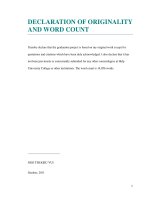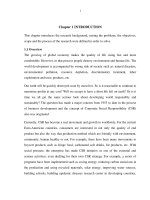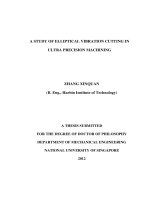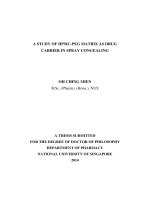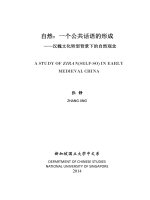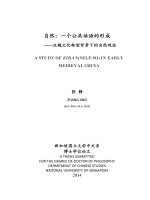Humor in everyday talks a study of vietnamese language learner’s communicative competence in intercultural settings
Bạn đang xem bản rút gọn của tài liệu. Xem và tải ngay bản đầy đủ của tài liệu tại đây (1.14 MB, 116 trang )
VIETNAM NATIONAL UNIVERSITY, HANOI
UNIVERSITY OF LANGUAGES AND INTERNATIONAL STUDIES
FACULTY OF POST-GRADUATE STUDIES
VŨ THỊ HỢI
HUMOR IN EVERYDAY TALKS: A STUDY OF VIETNAMESE LANGUAGE
LEARNER’S COMMUNICATIVE COMPETENCE
IN INTERCULTURAL SETTINGS
HÀI HƯỚC TRONG HỘI THOẠI HÀNG NGÀY: MỘT NGHIÊN CỨU
VỀ NĂNG LỰC GIAO TIẾP CỦA HỌC SINH VIỆT NAM TRONG BỐI CẢNH
GIAO TIẾP LIÊN VĂN HÓA
M.A. COMBINED PROGRAM THESIS
FIELD: ENGLISH TEACHING METHODOLOGY
CODE: 60140111
HANOI - 2016
VIETNAM NATIONAL UNIVERSITY, HANOI
UNIVERSITY OF LANGUAGES AND INTERNATIONAL STUDIES
FACULTY OF POST-GRADUATE STUDIES
VŨ THỊ HỢI
HUMOR IN EVERYDAY TALKS: A STUDY OF VIETNAMESE LANGUAGE
LEARNER’S COMMUNICATIVE COMPETENCE
IN INTERCULTURAL SETTINGS
HÀI HƯỚC TRONG HỘI THOẠI HÀNG NGÀY: MỘT NGHIÊN CỨU
VỀ NĂNG LỰC GIAO TIẾP CỦA HỌC SINH VIỆT NAM TRONG BỐI CẢNH
GIAO TIẾP LIÊN VĂN HÓA
M.A. COMBINED PROGRAM THESIS
FIELD: ENGLISH TEACHING METHODOLOGY
CODE: 60140111
SUPERVISOR: Dr. Hoàng Thị Hạnh
HANOI - 2016
Statement of Ownership
I hereby declare that this thesis is my own work and that, to the best of my
knowledge, it contained no material previously published or written by another
person (except where explicitly defined in the acknowledgements), nor material
which has been submitted for the award of any degree or diploma of a university or
other institutions of higher learning.
Signature:
……………………………….
Name:
Vũ Thị Hợi
Date :
……………………………….
i
Acknowledgements
At the completion of this thesis, I would like to express my deep gratitude to
Dr. Hoàng Thị Hạnh (my supervisor) of University of Languages and International
Studies – Vietnam National University for her constant and valuable guidance,
encouragement and support. Particularly, her critical comments on every single
piece of work of the thesis have contributed greatly to my learning, and to the
development of my research skills. Without her supervision, I would not have been
able to complete this thesis. However, shortcomings and errors, if any, in the thesis
are my own.
I would like to give my thanks to the students and volunteers who
participated in my studies though their name cannot be identified (for
confidentiality). This thesis could not have been completed without their ideas,
information and contribution. Thanks to their participation, patience and painstaking
efforts, this thesis has been done.
My thanks also go to Faculty of Postgraduate Studies, where I have studied
for two years, for providing me with valuable learning condition.
Last but not least, I would like to thank my parents, my sisters, and my
friends for their encouragements on my life-long learning, for their help on the
completion of this thesis.
ii
Abstract
Conversational humor in language teaching and learning has risen in
prominence since 1990s. Recently, there has been much interest in and debate
concerning conversational humor and how it links to participants‟ communicative
competence in intercultural situations. However, there has been little empirical
study into how humor is used and perceived by its participants, especially when all
of them are L2 speakers of English. This research reports on a qualitative study
investigating humor used by five L2 speakers of English in their everyday talks.
Although the limited number of instances reported means that further research is
needed to convincingly make generalizations, it is suggested that humor cannot be
perceived as stative and presumptive but as adaptive and emergent resources which
are negotiated and context-dependent. Therefore, conversational humor needs to
move beyond the traditionally conceived stative and context-independent as innate
traits, typical connecting tools to incorporate an awareness of cultural and
sociolinguistic differences in using humor and the skills needed to successfully
negotiate the meaning of humor in intercultural settings.
iii
Table of Contents
Statement of Ownership ...............................................................................................i
Acknowledgements .................................................................................................... ii
Abstract ..................................................................................................................... iii
Table of Contents .......................................................................................................iv
List of Transcript Conventions...................................................................................vi
Notes on Quotations from the Stimulated Recall Interviews ................................... vii
List of Abbreviations............................................................................................... viii
List of Tables..............................................................................................................ix
List of Figures .............................................................................................................x
PART 1: INTRODUCTION ......................................................................................1
CHAPTER 1: INTRODUCTION ...............................................................................1
1.1. Introduction ......................................................................................................1
1.2. Statement of problem and rationale..................................................................1
1.2.1. Statement of problem .................................................................................1
1.2.2. Rationale ....................................................................................................2
1.3. Purpose and significance of the study ..............................................................3
1.3.1. Purpose of the study...................................................................................3
1.3.2. Significance of the study ...........................................................................4
1.4. Structure of the thesis .......................................................................................4
PART 2: DEVELOPMENT ........................................................................................6
CHAPTER 2: LITERATURE REVIEW ....................................................................6
2.1. Introduction ......................................................................................................6
2.2. Humor ...............................................................................................................6
2.3. Humor in intercultural communication ............................................................7
2.4. Humor competence .........................................................................................10
2.5. Humor competence as a part of sociolinguistic competence .........................12
2.6. Summary.........................................................................................................15
CHAPTER 3: METHODOLOGY ............................................................................17
3.1. Introduction ....................................................................................................17
iv
3.2. Research questions .........................................................................................17
3.3. Participants .....................................................................................................17
3.4. Settings ...........................................................................................................19
3.5. Data collection methods .................................................................................19
3.5.1. Participant observations ...........................................................................19
3.5.2. Stimulated recall interviews ....................................................................21
3.6. Data analysis ...................................................................................................24
3.6.1. Transcript analysis ...................................................................................26
3.6.2. Thematic analysis ....................................................................................29
CHAPTER 4: HUMOR IN EVERYDAY INTERCULTURAL TALKS ................32
4.1. Introduction ....................................................................................................32
4.2. Humor as intention and the mismatch with humor comprehension ...............32
4.3. Humor and jokes on linguistic features ..........................................................38
4.4. Humor as the mark of the in-group ................................................................48
4.5. Conclusion ......................................................................................................52
CHAPTER 5: THE INTERACTIVE CONSTRUCTION OF HUMOR ..................53
5.1. Introduction ....................................................................................................53
5.2. The interactive construction of humor ...........................................................53
5.3. Thành‟s humor................................................................................................64
5.4. Summary.........................................................................................................69
PART 3: CONCLUSION ..........................................................................................71
CHAPTER 6: CONCLUSION ..................................................................................71
6.1. Conclusion ......................................................................................................71
6.2. Implications ....................................................................................................73
6.3. Limitations and further research .....................................................................74
REFERENCES ..........................................................................................................75
APPENDICES ............................................................................................................. I
v
List of Transcript Conventions
.
Indicate intonation that is a falling or final, not necessary at the end of
the sentence.
?
Indicate the rising tone, not necessary a question.
,
Indicate “continuing” intonation, not necessarily a clause boundary.
::
Indicate the prolongation or stretching of the sound just preceding
them. The more colons, the longer the stretching.
(?)
Inaudible
((laughs))
Nonlinguistic features of the transcription or transcriber‟s description
of the event.
(.)
Pause – untimed
(0.8)
Numbers in the parentheses indicate silence, represented in tenths of a
second, what is given here in the left margin indicates 0.8 seconds of
silence.
(…)
Indicate a section of dialogue that is not transcribed
[
Overlapping or interrupted speech
]
/n/
Phonemic transcription of sounds or words
=
The utterance on one line continues without a pause where the next =
picks it up.
Tell
Strong emphasis.
TELL
Especially loud voice
-
Indicate a cut-off or self-interruption.
hhh
Indicate hearable aspiration or represent breathing, laughter, etc. The
more h‟s, the more aspiration.
Indicate specific parts of an extract discussed in the text.
vi
Notes on Quotations from the Stimulated Recall Interviews (SRIs)
The Stimulated Recall Interview quotes were spoken in Vietnamese by two
Vietnamese participants with some code switching. Quotations from these data were
translated into idiomatic English by the researcher, with no attempt to reproduce
grammatical or lexical errors.
The following system was devised to reference quotations from the
participant observation extracts or the main task interactions:
TSRI1–06 ext.5–00:16:35
T:
Thành
Participant pseudonym
SRI:
Quotes taken from stimulated recall interview
1:
The order number of the interview
06:
The participant reflects on the corresponding line in the main
task interaction
ext.5:
The number of the extract in the main task interaction
00:16:35:
The beginning time of the quote in the interview.
JSRI1–07ext.4–00:38:15
J:
Jonas
Participant pseudonym
SRI:
Quotes taken from stimulated recall interview
1:
The order number of the interview
07:
The participant reflects on the corresponding line in the main
task interaction
ext.4:
The number of the extract in the main task interaction
00:38:15:
The beginning time of the quote in the interview.
vii
List of Abbreviations
ARs
Audio recordings
Ext.
Extract
L2
Second language (for example: L2 speakers, L2 learners)
NNSs
Non-native Speakers
NSs
Native Speakers
SRIs
Stimulated recall interviews
VRs
Video recordings
viii
List of Tables
Table 3.1: Demographic Information about the Participants ....................................18
Table 3.2: Information about Participant Observations ............................................20
Table 3.3: Video and Audio Recordings (VRs /ARs) ...............................................20
Table 3.4: Information about Stimulated Recall Interviews .....................................24
ix
List of Figures
Figure 2.1: Four-level Model of Humor Appreciation (Hay, 2001) ...........................9
Figure 2.2: Communicative Model (Canale & Swain, 1980, 1983) .........................13
Figure 2.3: Relationship between Humor Competence and Sociolinguistic
Competence ...............................................................................................................15
Figure 3.1: Procedure of Using Stimulated Recall Interviews (SRIs) ......................23
Figure 3.2: Information about data collection and analysis procedure .....................25
Figure 3.3: A streamlined codes-to-theory model for qualitative inquiry (Saldana,
2009)..........................................................................................................................31
x
PART 1: INTRODUCTION
CHAPTER 1: INTRODUCTION
1.1. Introduction
This thesis examines how humor is used in daily intercultural talks between
Vietnamese students and German volunteers and how they perceive the humor used
by their conversation partners. This first chapter introduces the research topic, and
the rationale of the present study in sections 1.1. Section 1.2 describes the purpose
and significance of the study. The last section outlines the structure for the research
presentation.
1.2. Statement of problem and rationale
1.2.1. Statement of problem
The purpose of teaching English is to develop learner‟s communicative
competence (Hymes, 1972, 1974; Canale & Swain, 1980, 1983; Damen, 1987;
Dodd, 1988; Park, 1994; Schinitzer, 1995; Ting-Toomey, 1999; Schmitz, 2002;
Lantolf, 2000, 2006; Fantini, 2006; Byram, 1997, 2000; Hoa, 2007; Moosmüller &
Schönhuth, 2009; Deardorff, 2009; Cetinavci, 2012). Canale and Swain (1980,
1983) divide communicative competence into four parts: (1) linguistic competence
or the ability to use the linguistic code, grammar, pronunciation, and vocabulary
correctly; (2) discourse competence which is the ability to maintain cohesion
between segments of discourse; (3) strategic competence which is the leamer's
ability to repair communication breakdown and work around gaps in his or her
knowledge of the target language, and finally (4) sociolinguistic competence or
learners‟ ability to use language appropriately in various social contexts (Byram,
1997). To assess the communicative competences when using English as an
international language, each competence cannot be viewed separately from its
context (Lantolf, 2000, 2006; Fantini, 2009; Byram, 1997, 2000; Hoa, 2007;
Moosmüller & Schönhuth, 2009; Deardorff, 2009; Cetinavci, 2012). This research,
regarding sociolinguistic competence, studies humor competence of Vietnamese
high school students who are fluent in linguistic competence when they come to
1
interact with German students using English as an international language. These
Vietnamese students can speak English with fluency in everyday talks. However,
when they use English as an international language to communicate with German
students, it is noticeable that there are still observable peculiar moments.
1.2.2. Rationale
Having a sense of humor helps us a lot in socializing. Trachtenberg (1979)
indicates that humor is indispensable in everyday socialization such as greeting
someone, introducing oneself, leaving a social meeting. Humor helps bring people
closer to each other (Askidson, 2005; Mak, 2008; Bell, 2006; Aboudan, 2009); clear
away tension atmosphere and make it enjoyable and meaningful (Attardo, 1994;
Alison, 1998; Bell, 2007a; Lundquist, 2009; Lynch, 2002; Crăciun, 2014); and
dispel the feeling of shyness and unconfidence (Bell, 2007a). Humor within the
language teaching can reduce affective barriers to language acquisition; stimulate
behaviors that are essential to success within a communicative context and create
conducive learning environment (Masten, 1986; Kang & Gianato, 1999; Sullivan,
2000; Askidson, 2005; Bell, 2005; Aboudan, 2009; Hoang, 2014).
Currently, there is a noticeable shift in humor research and theory from a
universal communication view point in which humor can be recognized by laughter,
smiling or linguistic cues such as “I‟m teasing you”, “I‟m joking”, or “it was so
funny” (Chiaro, 1992; Attardo, 1994; Carrell, 1997; Hay, 2001; Wiseman, 2002;
Andrew, 2010) to a personal and situated perspective in which humor is
constructed, perceived and negotiated in intercultural interaction (Lee, 1994; Lynch,
2002; Bell, 2006, 2007a, 2007b; Wiseman, 2002; Wiseman & Gonzalez, 2005;
Gervais & Wilson, 2005; Mak, 2008; Lundquist, 2009). This research is done,
taking the latter view point of humor, seeing humor as a part of sociolinguistic
competence. However, it is different from the previous studies on interactional
humor (Lee, 1994; Bell, 2006, 2007a, 2007b; Mak, 2008; Lundquist, 2009) in that
the participants in my research are all L2 speakers of English. Questions remain as
to the conditions under which L2 speakers may be more or less receptive to humor
2
created by the other L2 users and how they perceive and respond to such humor.
My research is an attempt to answer these questions.
1.3. Purpose and significance of the study
1.3.1. Purpose of the study
It is expected that this research will shed some light on conversational
humor. According to Attardo (1994) and Norrick (2009), conversational humor
focuses on how humor works closely with its context. They emphasize that if humor
is just found and analyzed in books or collections of jokes, its text does not depend
on contextual factors. Thus, it obviously bears little relationship to the ongoing
human interactions. Since Attardo‟s initiation (1994), conversational humor has
been the scholarship of many researchers, among them are Lee (1994); Carrell
(1997); Hay (2001); Bell (2002, 2006, 2007a, 2007b). However, these studies
mostly focus on the interactions between native speakers and non-native speakers.
Very little is known about humor in intercultural communication where
interlocutors are all L2 speakers of English.
The overarching questions addressed in this study have been formulated as:
How is humor used in daily intercultural talks between Vietnamese
students and German volunteers?
How do Vietnamese students and German volunteers perceive the
humor used by their conversation partners?
The overall objective of the study is to find out how humor in intercultural
communication is used, perceived, recognized, understood and appreciated by
participants who belong to different cultures, speak different languages but use
English to communicate in everyday talks. In a broad sense, this research aims at
constructing knowledge about conversational humor of Vietnamese learners when
they use English in their daily intercultural communication.
3
1.3.2. Significance of the study
This study aims at finding out how humor in intercultural communication is
perceived, recognized, understood and appreciated by participants who belong to
different cultures, speak different languages but use English to communicate in
everyday talks. Can humor help build rapport and strengthen relationships between
interlocutors as claimed by Mak (2008), Lee (1994), Bell (2006; 2007a) or cause
tension between them as the case of Pum using aggressive teasing in Bell (2007b)
or frequent play-on-word use and the overuse of irony among Danes in Lundquist
(2009)? Andrew (2010) states that efforts made to determine the crux behind humor
are greatly meaningful to the understanding of language and communication
strategies, psychology and cognitive processes, as well as social personal or cultural
values, beliefs, attitudes and perspectives. However, according to Andrew (2010),
most attempts at humor fail because one or more of the elements involving the
comprehension of humor such as personal, social factors, context, timing, and intent
are misinterpreted, ignored or too ambiguous. My research is intended to fill in this
gap by using the triangulation of data collection including participant observation,
and interviews. Thus, the factors effecting the success or failure of humor in
intercultural and interpersonal situations will be clarified.
1.4. Structure of the thesis
This thesis consists of six chapters. Chapter 1 introduces the research area
and the general background, as well as the purposes and significance of the study.
Chapter 2 is a brief literature review of the research topic. It explains the concepts
and theories underpinning the research. Chapter 3 describes research methodology
and the study design. Chapter 4 is an analysis of humor used by Vietnamese
students and German volunteers in their daily intercultural talks. Chapter 5 includes
interpretative and descriptive explanations on how Vietnamese students and German
volunteers perceived the humor used by their conversation partners. This chapter
addresses the central issues of the thesis, i.e. participants‟ perception of their
conversational partners‟ humor and to what extent. Chapter 6 is a summary of
4
findings and discussion on how Vietnamese students and German volunteers‟
sociolinguistic competence shown through their humor competence in daily
intercultural talks. This chapter also suggests further research to gain a deeper
insight into humor in intercultural communication, especially in situated English
teaching and learning.
5
PART 2: DEVELOPMENT
CHAPTER 2: LITERATURE REVIEW
2.1. Introduction
This study examines the use and perception of humor in daily intercultural
interactions. Humor, as a familiar concept in both daily life and academic fields, has
been conceptualized from various perspectives, hence the need for an
interdisciplinary knowledge. To provide the basic theoretical framework for the
study, this chapter commences with a review of humor definitions (section 2.2).
This is followed by a brief description of recent research into humor in intercultural
communication (section 2.3). Section 2.4 describes humor competence as a socialcognitive construct which is distinguishable from joke competence. The next
section (section 2.5) discusses relationship between humor competence and
sociolinguistic competence. The last section (section 2.6) is the summary of the
issues viewed.
2.2. Humor
Humor is defined in Oxford Advanced Learner‟s Dictionary as “the quality
in something that makes it amusing and funny or the ability to laugh at things that
are amusing” (Hornby et al., 2010). Alison (1998) defined humor as “something
that makes a person laugh or smile” (p. 1). Ziv (1988) saw “humor as a social
message intending to produce laughter or smiling” (p. ix). Humor “fulfills certain
functions uses, has content and used in certain situation” (p. ix).
The definition of what humor is, according to Attardo (1994), ultimately
depends on the purpose for which it is used. He points out, in the field of literary
criticism, for example, there is a need for a clear and distinct categorization whereas
linguists have often been happy with a broader meaning of humor, arguing that
whatever evokes laughter or is felt to be funny is humor. In other words, humor can
be deduced from its effect - laughter. Spanakaki (2007) defined humor as “whatever
intended to be funny, even if it might not always be perceived or interpreted as
such” (p. 2). Lynch (2002) characterized humor as both “intended or unintended
6
message” which is understood as funny (p. 423). Holmes (2000) emphasizing the
importance of analyst on identifying humor defined it “on the basis of
paralinguistic, prosodic and discoursal clues, as intended by the speaker(s) to be
amusing and perceived to be amusing by at least some participants” (p. 163). These
definitions have its problems because it is not easy to measure intention (Thorson &
Powell, 1993; Mackey & Gass, 2007). However, these definitions are useful in that
humor is a fundamentally social phenomenon can vary greatly in different cultures.
Within the purposes of this study, I have chosen to use “humor” as a generic term
covering any communicative acts with fun-inducing potential.
2.3. Humor in intercultural communication
Andrew (2010) suggests that although in intercultural communication, humor
is often used as a powerful speech act for breaking the ice, establishing relationships
or diffusing a difficult situation, the idea of “funny” is rarely interpreted universally
and is highly personal, context and culture specific. As a consequence, many jokes,
sarcastic or ironical remarks which may be deeply tied to one culture are often
unperceived, misunderstood or offensive, nonsensical in the others. He took the
conclusion of Kant (1951) as an example: “Laughter is an effect that arises if a tense
expectation is transformed into nothing” (p. 178). In other words, laughter does not
always bind to humor, people laugh in tension situations. Humor may produce other
reactions besides laughter and laughter may not always be a sign of amusement
(Andrew, 2010). In the same spirit, Attardo (1994) and Alison (1998) claim that
laughter can be delayed when hearers of jokes are faced with a dilemma; for
example, when their reaction may be socially unacceptable or the situation in which
laughter is inappropriate or the content of the joke is inappropriate. The hearers may
wait before they laugh in order to match their reactions with the other listeners.
Therefore, the interpretation of humor in intercultural communication based on
salient acts such as laughter or smiling is no longer trustful and the way we perceive
our humor cannot rely only on these cues.
It is undeniable that there are some types of universal humor (Wiseman,
7
2002; Andrew, 2010) but the interpretation of how they work in different cultures is
not an easy task. Andrew (2010) concluded that types of humor which do not
require specialized language, background knowledge or culture specific themes and
artifacts are more successful. In the same spirit, Schmitz (2002) categorized humor
discourse in three groups that are universal jokes; cultural jokes; and linguistic
jokes. A universal joke includes humor that is obtained mainly from the context and
the general function of the world. A cultural joke is based on cultural-background
knowledge. In order to understand and appreciate this type of joke, there is a need to
acquire abundant knowledge about the target society. The third group is linguistic
joke which is based on specific features in the phonology, morphology or syntax of
particular language. He provided the order of learnability for joke comprehension.
Learners can start with universal jokes, the cultural jokes and finally reach the
advanced level with linguistic jokes.
It can be seen from the category of Schmitz (2002) that cultural jokes can be
learnt and less complicated than linguistic jokes. This view of cultural joke or
humor poses a great challenge for anyone who wants to learn and use it in
intercultural communication. The reason is, as stated above, people in different
parts of the world tend to appreciate humor that is not culturally specific (Ziv, 1988;
Wiseman, 2002; Wilson, 2003). Besides, Andrew (2010) emphasized that cultural
difference is, not surprisingly, one of the greatest barriers to comprehension and
enjoyment. Therefore, one cultural joke can be used productively in this context
with these people but may have counter-effect in other contexts with other people.
Thus, cultural jokes are not static and cannot be learnt separately from context. It
seems that the best way for people who want to learn cultural jokes is to immerse
themselves in intercultural communication where cultural jokes are used and under
constant contest by interlocutors. Lundquist (2009) considered humor as a mediator
in intercultural professional settings. She concludes that “humor can neutralize
linguistic and cultural barriers and create a shared world” (p. 34) but frequent playon-word use and the overuse of irony among Danes caused general discomfort
8
among their French interlocutors (Lundquist, 2009). She advised Danes to be
careful in their use of irony for French to be aware of this specific form of Danish
humor. Especially, her finding of both Danish and French interlocutors who are not
afraid of making language errors in the foreign language contributes greatly to the
creation of new social shapes and ties.
As this thesis studies humor in intercultural conversations, I would like to
take Bell‟s (2007b) and Schmitz‟s (2002) view on humor which is both destructive
and constructive depending on the context; sociolinguistic background and
knowledge of the participants; and whether the conversation is among NNSs or
between NSs and NNSs (Bell, 2006, 2007a, 2007b). I would use Bell‟s (2007b)
humor competence framework in recognizing humor during the first phase of my
research on analyzing conversation transcripts. Bell (2007b) analyzes humor
according to joke competence/ recognition; humor competence/ understanding –
appreciation; humor and agreement as the mark in or out of the group; interactive
construction of humor and language building. This categorization is the further
development of Carrell‟s (1997) joke competence and humor competence in
combination with Hay‟s (2001) implicature theory of humor (see figure 2.1).
recognition
understanding
appreciation
agreement
Figure 2.1: Four-level Model of Humor Appreciation (Hay, 2001)
The greatest difference between my research and Bell‟s is that I focus on the
humor interactions between NNSs using English to communicate in everyday
situations. Thus, on analyzing the data, I see that when the participants are all L2
speakers, they tend to be more aware of different Englishes (vernacular, accent,
dialect, genre, variety) and the context of language use. They use their sense of
humor to explore even more about it (Ziv, 1988; Wiseman & Gonzalez, 2005). It is
likely that the relationship between linguistic and humorous interactional
adjustments that Bell (2007a) points out might work with my research. However, it
9
is too early to draw out any conclusion because L2 humor is influenced by multiple
aspects of participants‟ identities such as gender, personality, race, ethnicity, first
language, culture, foreign language proficiency and of course the context of the
interactional humor (Thorson & Powell, 1993; Bell, 2006, 2007a, 2007b; Wiseman
& Gonzalez, 2005; Gervais & Wilson, 2005).
2.4. Humor competence
As I stated above, joke competence and humor competence are distinct. Joke
competence refers to the recognition of jokes (mostly text or script analysis) while
humor deals with the understanding and appreciation of jokes and/or funny events
(Carrell, 1997; Hay, 2001; Bell, 2006, 2007a; Dynel, 2009). Carrell (1997) and Bell
(2007b) clarify that people may ask „„are you joking?‟‟ if the problem occurs within
their joke competence, but they may confess „„I don‟t get it‟‟ at their level of humor
competence. Attardo (2001b) distinguished between humor competence and humor
performance. He defined humor competence as “the capacity of a speaker to process
semantically a given text and to locate a set of relationships among its components,
such that he/she would identify the text (or part of it) as humorous in an ideal
situation” (Attardo, 2001b, p. 167). The latter, humor performance, is “the actual
encounter of two speakers (not necessarily physically co-present), in a given actual
place and time, i.e., in a given context” (Attardo, 2001b, p. 167). This distinction is
relevant to Chomsky‟s two terms (1965) “performance” and “competence” (p. 3) in
that competence is an idealized capacity, a psychological or mental property or
function, and “performance” is the production of actual utterances. In Chomsky‟s
view, people with linguistic competence can produce and understand an infinite
number of sentences in their language, and can differentiate grammatical sentences
from ungrammatical sentences. Hymes (1972) rejects Chomsky on the use of
“competence” which relates to “grammaticality” and “performance” referring to
“acceptability” (p. 281). Hymes addresses the importance of theory of
communication which puts “appropriateness” of communication acts to their
contexts in its centre (1974, p. viii). Joke competence may be evident from
10
analyzing text and script but humor competence is quite abstract for it links to the
cognitive “process” of interlocutors and highly embedded in the context (Attardo,
1994; Bell, 2007a).
Deardorff (2009) defined the word “process” as “a primitive theoretical
term” which “broadly implies systemic aspects of ongoing or continuous change
over time, functional interdependence, equifinality (different paths to the same
outcome), and multifinality (one path to multiple outcomes)” (p. 5). The word
“competence” is often understood as abilities or skills of doing something. It also
refers to “understanding (e.g., accuracy, clarity, co-orientation, overlap of
meanings), relationship development (e.g., attraction, intimacy), satisfaction (e.g.,
communication satisfaction, relational satisfaction, relational quality), effectiveness
(e.g., goal achievement, efficiency, institutional success, negotiation success),
appropriateness (e.g., legitimacy, acceptance, assimilation), and adaptation” (p. 6).
However, these definitions do not state the importance of context in interpreting
“competence” because the same behavior or skill can be perceived as competent
differently depending on various context and/or perceiver. Deardorff poses a more
convincing definition of competence as “the process of managing interaction in
ways that are likely to produce more appropriate and effective individual, relational,
group, or institutional outcomes” (Deardorff, 2009, p. 6).
In conclusion, humor competence is seen first as a cognitive process which
closely ties to individual and context (Chiaro, 1992; Lee, 1994; Hall, 1995; Carrell,
1997; Bell, 2002; Andrew, 2010). Also, humor competence is implicitly understood
through the word “competence” (Deardorff, 2009) as a social construct which is
closely related to the social rules of language such as appropriateness, formality,
politeness, and directness. Bell (2007a) reaffirms this view and suggests for further
research being done on conversational humor in interaction from sociolinguistic and
ethnographic perspectives. This research is intended to fill in this gap.
11
2.5. Humor competence as a part of sociolinguistic competence
Sociolinguistic competence, according to Canale & Swain (1980, 1983), is
one of four parts of communicative competences (see figure 2.2), and is defined as
the learner's ability to use language appropriately in various social contexts. Van Ek
defines sociolinguistic competence as the consciousness of choosing the appropriate
“language forms” in certain communicative situations (Byram, 1997, p. 48). As can
be seen from the definition of Canale & Swain and Van Ek, there is a close
relationship between linguistic use and their contextual or situational meaning.
Thus, sociolinguistic competence, as a part of communicative competence, is shown
through people‟s ability to produce utterances appropriate to the social situation in
which they are spoken. Sociolinguistic competence requires one's adjustments to
use the language which is appropriate to the setting the communication takes place
(Hall, 1995; Byram, 1997).
12
Linguistic competence
Strategic competence
Understanding and using:
Using techniques to:
Vocabulary
Overcome language gaps
Language convention (grammar,
Plan and assess the effectiveness of
punctuation and spelling)
communication
Syntax (e.g: sentence structure)
Achieve conversational fluency
Modify text for audience and
purpose
Communicative competence
The ability to understand and use language
effectively to communicate in “authentic”
social and school environment
Canale & Swain (1980, p. 6)
Having awareness of:
Social
rules
of
Understanding how ideas are
language
(e.g: connected through:
appropriateness, formality, politeness,
directness)
organization
Nonverbal behaviors
Cultural
Coherence and patterns of
references
Cohesive and transitional devices
(e.g:
idioms,
expressions, background knowledge)
Sociolinguistic competence
Discourse competence
Figure 2.2: Communicative Model (Canale & Swain, 1980, 1983)
As mentioned above, sociolinguistic competence closely links to the
appropriate use of language and is contested in communication. Humor, likewise,
needs high situation awareness and modification, and strongly connected to
interactants‟ language proficiency (Davies, 2003; Bell, 2005, 2006, 2007a, 2007b;
13

